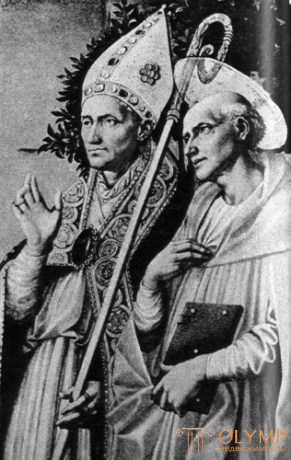
1. The development of the sculpture of the XVI century
Spanish sculpture of the XVI century was connected with architecture even more closely than in France. Strikingly, the many decorative sculptures that adorn the door and window trim, altars and altar barriers, and often the vaulted ceiling of the chapels. For example, from the ceiling the sacristy of the cathedral in Siguenz looks down three hundred heads. The architects were almost everywhere at the same time sculptors. The famous heavy pomp of the style, which only in some places gave way to a certain grace, is distinguished by the figured adornments of the Spanish facings in the style of the early Renaissance, however, under the newly appeared Italian influence, it quickly and somewhat abruptly turns to the Michelangean style. Along with decorative stone sculpture in Spain, wooden painted sculpture continued to flourish throughout the 16th century, mainly on large altars (retablos), which grew to the size of gigantic structures. Only here she was preparing for an even greater future. Djelafua studied it in detail. It is remarkable that many of the great masters of Spanish stone sculpture dedicated themselves to carving on wood and, as preserved samples show, sometimes they themselves performed the refined coloring of their best works in gold and paint ("al estofado").
The first Spanish sculptor of the early Renaissance is Bartolomeo Ordonec from Barcelona (died in 1520), who completed the tombstone of Cardinal Ximenes in Alcala de Genares after the death of Fancelli. He himself also did not have time to finish the tombstone of Philip the Beautiful and John the Mad in the Royal Chapel in Granada. The best of his works, in which the severity and grace are combined, are the two earliest reliefs of St. Eulalia on the choir barrier in Barcelona. Of the masters already known to us as architects, Diego de Silo, as a sculptor, gave the earliest and freshest his work in the genealogical tree of Christ on the altar of the St. Anne in the Burgos Cathedral, where his crudely executed tombstone of Bishop Acuña is also located, and the most mature and beautiful works are placed on the church portals in Granada, for example, on the portal of the roundabout (1534) of the cathedral, where the Madonna and Busts of the Apostles are placed. The best carved wooden altar in San Jeronimo in Granada, the luxurious kneeling figures of the donors of which were performed, apparently by him, was painted by someone else. Felipe Vigarni de Borgogna (d. 1543) is a very large master in the noble, delicate and luxurious alabaster reliefs of the Passion of Christ in the choir of the Burgos Cathedral, in the relief medallions and individual figures of images to the “Apostolic Messages” of the Cathedral in Toledo and cut from wood , painted "al estofado" the main altar of the Royal Chapel in Granada with masterful statues of the kneeling Ferdinand and Isabella. Alonso Berrugete (1480–1561), who returned from Rome in 1520 and belonged to the most zealous representatives of the cleaner, more mannered Italian, was actually a sculptor. His marble statue is half the full size of St. Levkadii above the entrance door of the Cristo de la Vega church near Toledo breathes the pure beauty of Andrea Sansovino. His work on the Lettner in Toledo (1548) went towards the Michelangelo manners more than the neighboring works of Vigarni. The tranquil, recumbent image of Cardinal Tavera at the Hospital de Afuera in Toledo is stately and spectacularly elevated above the mannered, in various poses, allegorical groups at the corners of the monument. Finally, Berrugete is a brilliant woodcarver and painter in the estofado style, especially in the fragments of the altarpiece of San Benito in the museum in Valladolid.
In the former kingdom of Arragone, Juan and Diego Morlanes, father and son, decorated after 1505 the facade of Santa Engracia in Zaragoza with figures and groups, in pure, noble forms among the late Gothic frames. Even more mature in the same direction are the works of Damian Formenta (died in 1535). Of these, the previously painted alabaster images from the life of the Virgin Mary on the main altar of the Cathedral del Pilar in Saragossa (1509 to 1515) are conceived in the late Gothic style, and the reliefs of the Passion of the Lord on the main altar of the cathedral in Guesque (1520–1533) are also made of alabaster and painted, represent the most pure and classic Renaissance style in Spanish sculpture.
In Seville, Pedro Millan, already mentioned in 1505, was the last representative of the Netherlands-Burgundian direction, as shown by his full lives painted terracotta statues under the dome of the cathedral, his gothic-attractive saints on the portal and full of strict grandeur of Señora del Pilar (Pilar Madonna) inside the cathedral. Pedro Torrigiano (1470–1522), rival of Michelangelo, whom we will meet in England, also ended his life in Seville and left here the famous painted terracotta statue of a kneeling saint. Jerome (in a museum in Seville), almost naked, with heeded knowledge of muscle play.
On the contrary, in Portugal, the subtleties of the early Renaissance were cultivated; it was in that French colony of sculptors in Coimbra, whose chief masters Nicholas "Franzoza" and João de Royo (Jean de Rouen) decorated the portal and the chair of the church with perfectly executed and subtly conceived sculptures.

Fig. 93. Relief with the image of St. Jerome
Что бы оставить комментарий войдите
Комментарии (0)